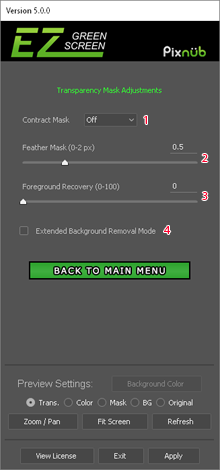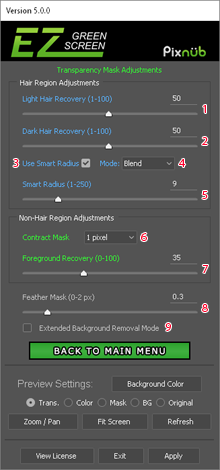The mask adjustment menu will have different features depending on whether the extraction was done in dual mask or single mask mode. In dual mask mode, the software algorithm has features to recover stray edge hair. The amount of stray hair that can be recovered will depend on the image resolution, how focused the edges hair is, the contrast of the hair to the background and the amount of noise in the image.
If the image has good contrast, high resolution and the edge hair is sharp then the hair recovery can work quite well. However, if the hair edges are blurred due to either poor focusing or shallow depth of field, the then edge hair will blur into the background and it can't be recovered. Also, images shot at very high ISO with a lot of noise or low resolution images won't work as well for edge hair recovery. Basically, EZ Green Screen can only extract with the level of detail that is contained in the original image. If the image lacks hair detail to begin with then no software can add detail to the image. For these cases, single mask extractions are your best option.

1: Contract Mask: This contracts the foreground area by 1, 2 or 3 pixels. It is used to clean up edge haloing.
2: Feather Mask This softens the mask edges so the edges blend better and don't look "cut". Usually, 0.3-0.5 pixels is all that is needed. However, for some images in single mask, a higher feathering value in combination with contracting the mask will give a nice blended result.
3: Foreground recovery: This can be used to automatically recover foreground mask areas from some areas that were "greenish". The areas include off green colored clothing or heavy spill areas in the foreground. The foreground recovery WILL NOT recover chroma key colored clothing. For chroma key colored clothing, you will need to use the Add or Remove Areas feature instead.
4: Extended Background Removal: This can automatically extract some problem areas in the screen such as shadows, hot spots, and areas with color variation. This WILL NOT fix all issues from improper green screen set up. Also, Using the extended removal mode may erase or partially erase parts of the foreground.
Normally, you should not need to use the extended removal mode. If you do need to use it then you should evaluate your green screen set up and make improvements where needed.

1: Light Hair Recovery: This attempts to recover light hair. 50 is the default value. If you don't want to recover light edge hair then you can turn this down and it will not recover any light hair (may need to turn off smart radius as well). Sometimes this can be pushed up a little. However, you usually can't increase this value too much without bringing the screen partially into the image.
2: Dark Hair Recovery: This attempts to recover dark hair. 50 is the default value. If you don't want to recover dark edge hair then you can turn this down and it will not recover any light hair (may need to turn off smart radius as well). Sometimes this can be pushed up a little. However, you usually can't increase this value too much without bringing the screen partially into the image.
3: Use Smart Radius: EZ Green Screen has 2 modes for hair recovery. First it will recover what it can with the slider settings. Then it will run a Smart Radius on the mask after it has recovered using the slider adjustments. This uses the standard Photoshop smart radius except it can be blended together with EZ Green Screen's native recovery method. As a general rule for green screen, smart radius works very well for dark hair. For blonde hair, the smart radius can "smear" the mask in the hair region. For blonde hair, it is best to leave the smart radius at a low value or to uncheck it so it isn't used. For blonde hair, you can often get a better mask by using the light hair recovery slider only.
4: Smart Radius Mode: This can be set to blend or replace. When in replace mode, the native EZ Green Screen mask is replaced with the smart radius mask in the hair region. This can sometimes give a softer edge which can be wanted at times. However, the smart radius can encroach into the hairline and partially extract areas that belong in the foreground.
When in blend mode mode, the native EZ Green Screen mask will be mixed with the Photoshop smart radius mask. The blending is done using lighten blend mode. What this does is keep the opacity for both masks. Additional hair detail that is captured by smart radius is added to the mask. However, it will not erase any areas that are captured by the EZ Green Screen native mask.
5: Smart Radius: Sets the radius in pixels for the smart radius feature.
6: Contract Mask: This contracts the foreground area by 1, 2 or 3 pixels. It is used to clean up edge haloing. In dual mask mode, this IS NOT applied inside the hair region.
7: Foreground recovery: This can be used to automatically recover foreground mask areas from some areas that were "greenish". The areas include off green colored clothing or heavy spill areas in the foreground. The foreground recovery WILL NOT recover chroma key colored clothing. For chroma key colored clothing, you will need to use the Add or Remove Areas feature instead. In dual mask mode, this IS NOT applied inside the hair region.
8: Feather Mask This softens the mask edges so the edges blend better and don't look "cut". For dual mask, it is usually best to keep this value low so that the recovered hair detail is not blurred. A value from 0-0.3 is usually best. 0.3 is the software default value.
9: Extended Background Removal: This can automatically extract some problem areas in the screen such as shadows, hot spots, and areas with color variation. This WILL NOT fix all issues from improper green screen set up. Also, Using the extended removal mode may erase or partially erase parts of the foreground. In dual mask mode, this IS NOT applied inside the hair region.
Normally, you should not need to use the extended removal mode. If you do need to use it then you should evaluate your green screen set up and make improvements where needed.
© Pixnub Software